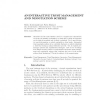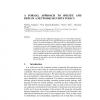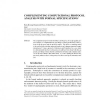IFIP
2004
Springer
14 years 8 months ago
2004
Springer
IFIP
2004
Springer
14 years 8 months ago
2004
Springer
We extend a particular access control framework, the Privilege Calculus, with a possibility to override denied access for increased flexibility in hard to define or unanticipated...
IFIP
2004
Springer
14 years 8 months ago
2004
Springer
The most studied property, secrecy, is not always sufficient to prove the security of a protocol. Other properties such as anonymity, privacy or opacity could be useful. Here, we u...
IFIP
2004
Springer
14 years 8 months ago
2004
Springer
Interactive access control allows a server to compute and communicate on the fly the missing credentials to a client and to adapt its responses on the basis of presented and decli...
IFIP
2004
Springer
14 years 8 months ago
2004
Springer
IFIP
2004
Springer
14 years 8 months ago
2004
Springer
This paper focuses on the usability of the PINPAS tool. The PINPAS tool is an instruction-level interpreter for smartcard assembler languages, augmented with facilities to study si...
IFIP
2004
Springer
14 years 8 months ago
2004
Springer
Cryptographic protocols often make use of nested cryptographic primitives, for example signed message digests, or encrypted signed messages. Gordon and Jeffrey’s prior work on ty...
IFIP
2004
Springer
14 years 8 months ago
2004
Springer
Current firewall configuration languages have no well founded semantics. Each firewall implements its own algorithm that parses specific proprietary languages. The main conseq...
IFIP
2004
Springer
14 years 8 months ago
2004
Springer
We propose a language that allows agents to distribute data with usage policies in a decentralized architecture. In our framework, the compliance with usage policies is not enforce...
IFIP
2004
Springer
14 years 8 months ago
2004
Springer
Abstract The computational proof model of Bellare and Rogaway for cryptographic protocol analysis is complemented by providing a formal specification of the actions of the adversa...




